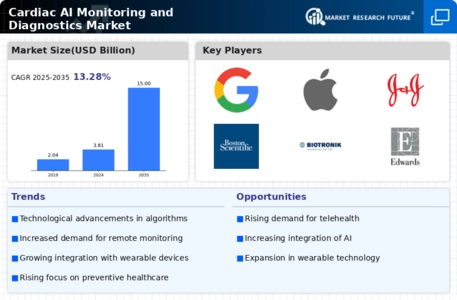Regulatory Support for AI in Healthcare
Regulatory bodies are increasingly supporting the integration of AI technologies in healthcare, which serves as a crucial driver for the Cardiac AI Monitoring and Diagnostics Market. Initiatives aimed at streamlining the approval processes for AI-based medical devices are emerging, encouraging innovation and adoption. This regulatory support not only enhances the credibility of AI solutions but also instills confidence among healthcare providers and patients. As regulations evolve to accommodate the unique challenges posed by AI, the market is likely to experience accelerated growth, with more stakeholders entering the field and contributing to advancements in cardiac diagnostics.
Rising Prevalence of Cardiovascular Diseases
The increasing incidence of cardiovascular diseases is a primary driver for the Cardiac AI Monitoring and Diagnostics Market. According to recent statistics, cardiovascular diseases account for a substantial portion of global mortality rates, prompting healthcare systems to seek innovative solutions. The integration of AI technologies in monitoring and diagnostics offers the potential for early detection and improved patient outcomes. As the population ages and lifestyle-related health issues become more prevalent, the demand for advanced cardiac monitoring solutions is expected to rise. This trend indicates a growing market for AI-driven tools that can assist healthcare professionals in managing cardiovascular health more effectively.
Increased Investment in Healthcare Technology
The surge in investment directed towards healthcare technology is a notable driver for the Cardiac AI Monitoring and Diagnostics Market. Governments and private entities are recognizing the importance of integrating advanced technologies into healthcare systems. This financial backing facilitates the development and deployment of AI-based cardiac monitoring solutions. Reports indicate that investments in health tech are projected to reach unprecedented levels, fostering innovation and accelerating the adoption of AI tools in cardiology. As funding increases, the market is likely to witness a proliferation of new products and services aimed at enhancing cardiac care.
Advancements in Artificial Intelligence Technologies
Technological advancements in artificial intelligence are significantly influencing the Cardiac AI Monitoring and Diagnostics Market. Innovations in machine learning algorithms and data analytics are enhancing the accuracy and efficiency of cardiac diagnostics. For instance, AI systems can analyze vast amounts of patient data to identify patterns that may elude human practitioners. This capability not only improves diagnostic precision but also streamlines workflows in clinical settings. As AI technologies continue to evolve, their application in cardiac monitoring is likely to expand, leading to more sophisticated tools that can provide real-time insights into patient health, thereby driving market growth.
Growing Demand for Remote Patient Monitoring Solutions
The demand for remote patient monitoring solutions is rapidly increasing, significantly impacting the Cardiac AI Monitoring and Diagnostics Market. With the rise of telehealth and the need for continuous patient engagement, healthcare providers are increasingly adopting AI-driven monitoring systems. These systems enable real-time tracking of patients' cardiac health, allowing for timely interventions and reducing hospital visits. Market analysis suggests that the remote patient monitoring segment is expected to grow substantially, driven by the need for efficient management of chronic conditions. This trend underscores the importance of AI technologies in facilitating remote care and improving patient outcomes.


















Leave a Comment